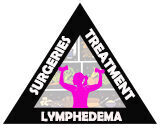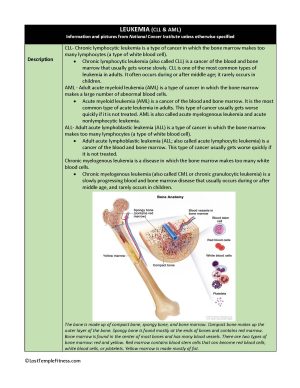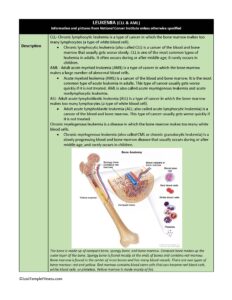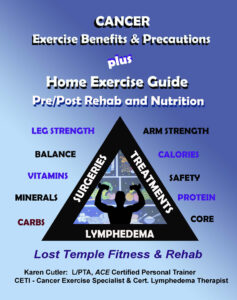Leukemia (CLL & AML)
Your Body is Your Temple
Research, Resources & Education
Table of Contents
Leukemia is a cancer of the blood-forming tissues characterized by a large increase in the numbers of white blood cells (leukocytes) in the circulation or bone marrow. A number of different leukemias are classified according to the course of the disease and the predominant type of white blood cell involved.
Information and pictures from National Cancer Institute unless otherwise specified
Types of Leukemia and Bone Anatomy

The bone is made up of compact bone, spongy bone, and bone marrow.
- Compact bone makes up the outer layer of the bone.
- Spongy bone is found mostly at the ends of bones and contains red marrow.
- Bone marrow is found in the center of most bones and has many blood vessels.
- There are two types of bone marrow: red and yellow.
- Red marrow contains blood stem cells that can become red blood cells, white blood cells, or platelets.
- Yellow marrow is made mostly of fat.
- There are two types of bone marrow: red and yellow.
CLL- Chronic lymphocytic leukemia is a type of cancer in which the bone marrow makes too many lymphocytes (a type of white blood cell).
- Chronic lymphocytic leukemia (also called CLL) is a cancer of the blood and bone marrow that usually gets worse slowly.
- CLL is one of the most common types of leukemia in adults. It often occurs during or after middle age; it rarely occurs in children.
AML – Adult acute myeloid leukemia (AML) is a type of cancer in which the bone marrow makes a large number of abnormal blood cells.
- Acute myeloid leukemia (AML) is a cancer of the blood and bone marrow.
- It is the most common type of acute leukemia in adults.
- This type of cancer usually gets worse quickly if it is not treated.
- AML is also called acute myelogenous leukemia and acute nonlymphocytic leukemia.
ALL- Adult acute lymphoblastic leukemia (ALL) is a type of cancer in which the bone marrow makes too many lymphocytes (a type of white blood cell).
- Adult acute lymphoblastic leukemia (ALL; also called acute lymphocytic leukemia) is a cancer of the blood and bone marrow.
- This type of cancer usually gets worse quickly if it is not treated.
Chronic myelogenous leukemia is a disease in which the bone marrow makes too many white blood cells.
- Chronic myelogenous leukemia (also called CML or chronic granulocytic leukemia) is a slowly progressing blood and bone marrow disease that usually occurs during or after middle age, and rarely occurs in children.
Leukemia Videos
YouTube Videos that help explain Leukemia
Disclaimer:
This is for research only and Lost Temple Fitness & Cancer does not endorse any video presented on this website.
It is advised that you ALWAYS CHECK WITH YOUR PHYSICIAN for a proper diagnosis and treatment plan.
Leukemia Playlist
CLL and AML & Treatments
Also see Treatments
Chronic lymphocytic leukemia is a type of cancer in which the bone marrow makes too many lymphocytes (a type of white blood cell).
- Chronic lymphocytic leukemia (also called CLL) is a blood and bone marrow disease that usually gets worse slowly.
- CLL is one of the most common types of leukemia in adults. It often occurs during or after middle age; it rarely occurs in children.
- Leukemia may affect red blood cells, white blood cells, and platelets.
- Normally, the body makes blood stem cells (immature cells) that become mature blood cells over time.
A blood stem cell may become a myeloid stem cell or a lymphoid stem cell.
A myeloid stem cell becomes one of three types of mature blood cells:
- Red blood cells that carry oxygen and other substances to all tissues of the body.
- White blood cells that fight infection and disease.
- Platelets that form blood clots to stop bleeding.
A lymphoid stem cell becomes a lymphoblast cell and then one of three types of lymphocytes (white blood cells):
- B lymphocytes that make antibodies to help fight infection.
- T lymphocytes that help B lymphocytes make antibodies to fight infection.
- Natural killer cells that attack cancer cells and viruses.
In CLL, too many blood stem cells become abnormal lymphocytes and do not become healthy white blood cells.
- The abnormal lymphocytes may also be called leukemia cells.
- The lymphocytes are not able to fight infection very well.
- Also, as the number of lymphocytes increases in the blood and bone marrow, there is less room for healthy white blood cells, red blood cells, and platelets. This may cause infection, anemia, and easy bleeding.
Targeted Therapy
- Targeted therapy with any of the following drugs:
- Ibrutinib with or without rituximab or obinutuzumab.
- Venetoclax with or without rituximab or obinutuzumab.
- Acalabrutinib with or without rituximab or obinutuzumab.
- Chemotherapy and rituximab.
Immunotherapy
- Immunotherapy is a treatment that uses the patient’s immune system to fight cancer.
- Substances made by the body or made in a laboratory are used to boost, direct, or restore the body’s natural defenses against cancer.
- This cancer treatment is a type of biologic therapy.
- Immunomodulating agent:
- Lenalidomide stimulates T cells to kill leukemia cells. It may be used alone or with rituximab in patients with symptomatic or progressive, recurrent, or refractory CLL.
- CAR T-cell therapy: This treatment changes the patient’s T cells (a type of immune system cell) so they will attack certain proteins on the surface of cancer cells.
- T cells are taken from the patient and special receptors are added to their surface in the laboratory.
- The changed cells are called chimeric antigen receptor (CAR) T cells.
- The CAR T cells are grown in the laboratory and given to the patient by infusion.
- The CAR T cells multiply in the patient’s blood and attack cancer cells. CAR T-cell therapy is being studied in the treatment of recurrent or refractory CLL.
Chemotherapy with bone marrow or peripheral stem cell transplant
- Chemotherapy is given to kill cancer cells.
- Healthy cells, including blood-forming cells, are destroyed by the cancer treatment.
- A bone marrow or peripheral stem cell transplant are treatments to replace the blood-forming cells.
- Stem cells (immature blood cells) are removed from the blood or bone marrow of the patient or a donor and are frozen and stored.
- After the patient completes chemotherapy, the stored stem cells are thawed and given back to the patient through an infusion.
- These reinfused stem cells grow into (and restore) the body’s blood cells.
Watchful waiting
Radiation therapy
A clinical trial of bone marrow or peripheral stem cell transplantation.
Adult acute myeloid leukemia (AML) is a type of cancer in which the bone marrow makes abnormal myeloblasts (a type of white blood cell), red blood cells, or platelets. This is a cancer of the blood and bone marrow.
- This type of cancer usually gets worse quickly if it is not treated.
- It is the most common type of acute leukemia in adults.
- AML is also called acute myelogenous leukemia, acute myeloblastic leukemia, acute granulocytic leukemia, and acute nonlymphocytic leukemia.
See CLL for myeloid stem cell types.
- In AML, the myeloid stem cells usually become a type of immature white blood cell called myeloblasts (or myeloid blasts).
- The myeloblasts in AML are abnormal and do not become healthy white blood cells.
- Sometimes in AML, too many stem cells become abnormal red blood cells or platelets.
- These abnormal white blood cells, red blood cells, or platelets are also called leukemia cells or blasts.
- Leukemia cells can build up in the bone marrow and blood so there is less room for healthy white blood cells, red blood cells, and platelets.
- When this happens, infection, anemia, or easy bleeding may occur.
- The leukemia cells can spread outside the blood to other parts of the body, including the central nervous system (brain and spinal cord), skin, and gums.
There are different subtypes of AML. Most AML subtypes are based on how mature (developed) the cancer cells are at the time of diagnosis and how different they are from normal cells.
- Acute promyelocytic leukemia (APL) is a subtype of AML that occurs when parts of two genes stick together.
- APL usually occurs in middle-aged adults.
- Signs of APL may include both bleeding and forming blood clots.
The treatment of adult AML usually has 2 phases.
- Remission induction therapy: This is the first phase of treatment. The goal is to kill the leukemia cells in the blood and bone marrow. This puts the leukemia into remission.
- Post-remission therapy: This is the second phase of treatment. It begins after the leukemia is in remission. The goal of post- remission therapy is to kill any remaining leukemia cells that may not be active but could begin to regrow and cause a relapse.
- This phase is also called remission continuation therapy.
Stem Cell Transplant
A procedure in which a patient receives healthy stem cells (blood-forming cells) to replace their own stem cells that have been destroyed by treatment with radiation or high doses of chemotherapy.
- The healthy stem cells may come from the blood or bone marrow of the patient or from a related or unrelated donor.
- A stem cell transplant may be autologous (using a patient’s own stem cells that were collected and saved before treatment), allogeneic (using stem cells from a related or unrelated donor), syngeneic (using stem cells donated by an identical twin), or cord blood (using umbilical cord blood donated after a baby is born).
Chemotherapy with stem cell transplant
Chemotherapy is given to kill cancer cells.
- Healthy cells, including blood-forming cells, are also destroyed by the cancer treatment.
- Stem cell transplant is a treatment to replace the blood-forming cells.
- Stem cells (immature blood cells) are removed from the blood or bone marrow of the patient or a donor and are frozen and stored. After the patient completes chemotherapy and/or total-body irradiation, the stored stem cells are thawed and given back to the patient through an infusion.
- These reinfused stem cells grow into (and restore) the body’s blood cells.
Targeted therapy
Targeted therapy is a type of treatment that uses drugs or other substances to identify and attack specific cancer cells.
Targeted therapies usually cause less harm to normal cells than chemotherapy or radiation therapy do. There are different types of targeted therapy:
- Monoclonal antibodies: Monoclonal antibodies are immune system proteins made in the laboratory to treat many diseases, including cancer.
- Gemtuzumab ozogamicin is a type of antibody-drug conjugate used to treat patients with newly diagnosed or relapsed AML. It contains a monoclonal antibody that binds to CD33, which is found on some leukemia cells, and also contains a toxic substance, which may help kill cancer cells.
Midostaurin, a protein kinase inhibitor used with certain types of chemotherapy to treat newly diagnosed patients with AML that has a mutation in the FLT3 gene. - Gilteritinib, a tyrosine kinase inhibitor that may be used to treat patients with AML that has come back or did not get better with other treatment and has a mutation in the FLT3 gene.
Glasdegib, ivosidenib, and enasidenib, which may be used as less intensive treatments in older or frail patients who cannot receive standard treatment.
Other drug therapy
- Arsenic trioxide and all-trans retinoic acid (ATRA) are anticancer drugs that kill leukemia cells, stop the leukemia cells from dividing, or help the leukemia cells mature into white blood cells.
- These drugs are used in the treatment of a subtype of AML called acute promyelocytic leukemia.
Radiation therapy
Chemotherapy
Risk Factors
- Being male.
- Older age.
- Smoking.
- Having had treatment with chemotherapy or radiation therapy in the past.
- Being exposed to radiation in the environment (such as nuclear radiation) or to the chemical benzene.
- Having a personal history of a blood disorder such as myelodysplastic syndrome.
- Having certain syndromes or inherited disorders.
Disclaimer: The information in this book/website is for educational purposes only and has been obtained through research, publications and personal experience, and shall not be liable for incorrect information. Any mentioned publications or websites does not imply endorsement. As this industry is ever changing, I urge readers to confirm the information contained in this book/website. The author will not be liable for any injuries sustained from practicing techniques taught or for any typographical errors or omissions.
It is advised that you always check with your medical doctor or physical therapist before starting an exercise program or change in diet.
|
Information and pictures from National Cancer Institute unless otherwise specified |




